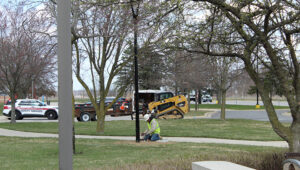MCCC has partnered with DTE and their Community Lighting Program on a project to replace and/or install new lighting fixtures on campus with new LED alternatives.
“The majority of the existing light poles were replaced, but there were some that we reused, however with those new heads were installed,” Jack Burns, director of campus and planning facilities, said in an email.
The project, which was started in January 2024, will have replaced and or installed 222 new lighting fixtures throughout the parking lot, drive and sidewalk by the end of April 2024.
The total cost of the project is more than $383,000, but DTE agreed to pay over 60% of that price, meaning DTE will pay more than $247,000.

“We will pay an annual fee for the program of $68,798.39 which again includes not only maintenance and upkeep, but also the usage as all the new lighting will be on a separate electrical meter than the rest of campus,” Burns said.
DTE will also be paying the taxes.
“Another noteworthy financial aspect of this project is that since all of the site lighting belongs to DTE they will pay the taxes on the equipment in a cash disbursement to Monroe Charter Township, which is the jurisdiction in which Main Campus lies,” Burns said.
Burns said a majority of the lighting on campus was from when the college first opened in 1967, so spare parts were nearly impossible to acquire.
“In fact a few years ago when campus was hit by a severe thunderstorm hail from that event completely destroyed nearly 30 of the sidewalk globes, and we were lucky to find some replacements on eBay that were sitting on a shelf at an electrical supply company in Nebraska,” Burns said. “This was very fortunate for us as those globes were discontinued by the manufacturer over 20 years ago.”
Besides the light poles being outdated, Burns said they were also rusted out and failing at the base, which led to problems whenever routine or emergency maintenance had to be performed. Along with that, adapters had to be installed whenever a lamp bulb went out to make them work with their modern replacements, Burns said.
This project, along with the campus-wide geothermal HVAC system, is a push to move MCCC toward a more net zero carbon operation.
Currently, the annual amount of electricity used for site lighting totaled 166,301 kilowatt hours (kw/h). Upon completion of the project, the numbers are anticipated to drop to 93,292 kw/h, which is a 43.9% decrease.
“Unless you are an engineer that won’t mean much to you, so using the EPA’s Greenhouse Gas Equivalencies Calculator our anticipated annual reduction is the same as avoiding 130, 462 miles driven by the average gas-powered vehicle, or powering 10.1 U.S. homes per year, or saving 59.6 acres of forests from being cut down,” Burns said.
Additionally, the usage of LED lights will decrease the amount of light pollution, which is better for the local plants and nocturnal animals.
Burns said this project was not a Board of Trustees matter, but a matter for the legal counsel and signed by Curtis Creagh, vice president of finance and administration, and/or President Kojo Quartey.

